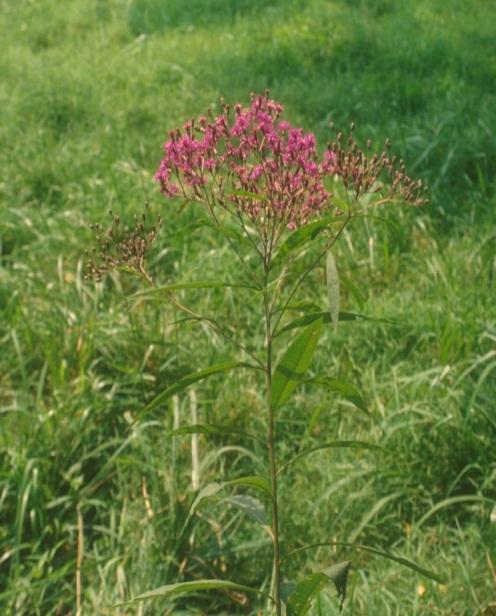Tall Ironweed Control in Grazed Pastures
By J. D. Green, Extension Weed Scientist
 Tall ironweed (Vernonia altissma Nutt.) is one of the more commonly found weeds in grazed pasture fields and other non-cropland areas (Figure 1). In Kentucky, tall ironweed is ranked as the most troublesome and third-most common weed found in grazed pastures. The quantity of grass available for grazing can be substantially reduced in pastures by the presence of tall ironweed because of its unpalatability to livestock. This further leads to an increase in tall ironweed populations over time as animals graze and selectively avoid this weed.
Tall ironweed (Vernonia altissma Nutt.) is one of the more commonly found weeds in grazed pasture fields and other non-cropland areas (Figure 1). In Kentucky, tall ironweed is ranked as the most troublesome and third-most common weed found in grazed pastures. The quantity of grass available for grazing can be substantially reduced in pastures by the presence of tall ironweed because of its unpalatability to livestock. This further leads to an increase in tall ironweed populations over time as animals graze and selectively avoid this weed.
Mowing alone can help suppress top growth of tall ironweed plants, but does not reduce plant populations. Mowing or clipping pasture fields, which is often performed once per year, can also lead to more multi-stemmed tall ironweed plants. Whereas, using a timely herbicide application in problem fields is one method to effectively reduce tall ironweed populations. Based on several field research studies, tall ironweed populations can be reduced 80-95% the year following herbicide treatment when combined with other management strategies.
An herbicide-based control program for tall ironweed in grazed pastures may require a 12- to 18-month time period to reduce tall ironweed populations and allow for reestablishment of clover. Tall ironweed control should start in early to mid-July by mowing emerged tall ironweed stems. Mowing removes top growth of currently emerged plants, which often have older, tattered leaves. This also forces the plant to use more stored energy from its roots to develop new shoots. When plants regrow 10 to 20 inches in height (generally in mid- to late August) the younger stems and leaves are more conducive for herbicide uptake. In August or by early September, apply a pasture herbicide containing either triclopyr (eg. PastureGard, Crossbow, etc.) or aminopyralid (eg. GrazonNext, etc.) as a broadcast treatment. Although mid-summer (June and July) treatments can provide good control, better herbicide movement to the root system occurs with perennial weeds such as tall ironweed with late summer applications. Consult product label or Extension bulletins for recommended use rates for herbicides.
One of the drawbacks to the application of broadleaf pasture herbicides is that they can impact desirable clover stands. Emerged clover within the treated areas of the field are likely to be killed. Consult the herbicide label of the product used for minimum reseeding intervals for clovers and other desirable forage grasses. Also, observe other precautions prior to application.
This approach for tall ironweed control is best suited for fields with moderate to heavy tall ironweed populations. For lighter infestations levels, a spot treatment of individual plants may be warranted to keep tall ironweed populations from becoming a major problem. Use of rope wick applicators and roller wipers have also been evaluated for tall ironweed control as a method to minimize injury to clover. However, the results have consistently been less successful than broadcast herbicide treatments for control of tall ironweed.
Categories:
Summer
Weed Control


